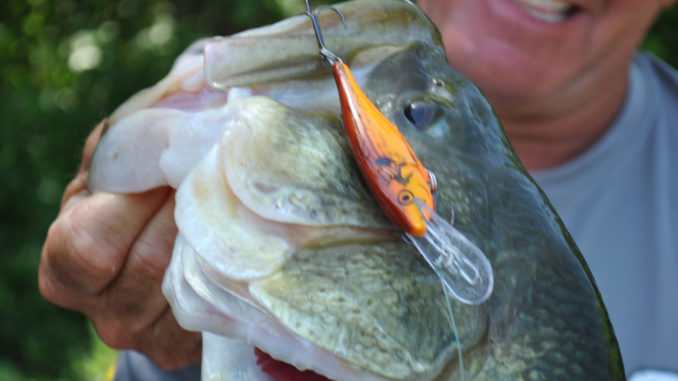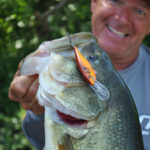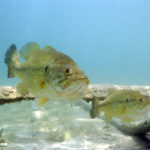
With fish ganged up offshore, it’s the way to go
Summer arrives across South Carolina this month, and when I think about June, I immediately think about starting to fish offshore in most of our lakes. I believe June is the best month to catch fish on a crankbait. Fish are schooling, and you can catch quality fish and good numbers of fish — sometimes on just one or two spots.
In most lakes, bass have been shallow all spring, hanging around whatever cover was available: grass, docks, willow bushes. When they’re shallow, they’re usually scattered, doing their spawning thing, and when they move offshore, then tend to gang up, and it’s great to get out and fish for schools of fish. You have to change your mindset from going down the bank and catching a fish every 50 or 100 yards to fishing a lot of water and not catching anything, then finding them and loading up, catching multiple fish from one spot, catching them on consecutive casts — that’s fun.
Most of the time, I’m going to have Rapala DT-10s and DT-14s tied on in June. The “DT” means “Down to” and the number is how many feet they’re going to run. It’s really important that you know how deep you’re going to be able to get your bait. If you want it to dig along the bottom in 14 feet of water, of if you need to get it down to a brush pile in 10 feet of water, that’s what you need to know. I think people often think their baits run deeper than they really do, and your casting ability, the rod and reel you’re using and the line size can all have an effect on it.
I fish crankbaits on a 7-foot, medium-action BPS Crankin’ Stick baitcasting rod. It’s a composite rod, glass and graphite. Everything else I fish has a fast-taper and is graphite, but when you’re fishing crankbaits, you need a little more of that parabolic effect with your rod.
I think you’ll hook fish better with a soft rod, and you can keep a better bend in your rod with a soft rod when you’re trying to keep slack out when a fish jumps. You’re going to land more fish with a composite rod. When you get a fish close to the boat, you need that softer action so he can’t make a sudden move and get a little slack to throw your lure.
Landing fish on a crankbait is a little different, because they can get leverage on your and jump off. If you’re just fishing for fun and have a landing net and a partner, net every fish you can. If you don’t have a net or you’re fishing in a tournament that doesn’t allow nets, you have to be very careful. I really like to wear out a fish before I try to bring him to the side of the boat to land, and I like to keep a good bend in my rod in case he surges. If you get him worn out, you won’t feel so worried about reaching down there and grabbing him by the lip when he’s got those treble hooks banging around.
I fish a Johnny Morris Signature Series baitcasting reel with a 5-to-1 gear ratio. I know a lot of fishermen have different opinions on slow or fast reels. My answer is, if it feels good to you, use it. I like fishing a crankbait with a slower retrieve, so the slower reel helps me. I spool my reels with 10- to 12-pound XPS fluorocarbon. Line diameter often makes a big difference in how deep a bait runs. If you’re fishing monofilament, the difference between 10- and 12-pound test might be a foot or as much as 2 feet. There’s not as much difference with fluorocarbon, because the diameter is smaller, and because it’s a little heavier.
A crankbait is a really good search bait when you’re looking for offshore fish. I’m usually going to be fishing a shad or blueback herring color anywhere I go. I search with my Humminbird electronics looking for cover: brush piles, grass beds, stumps. I’m searching with my crankbait at the same time.
If you catch a fish, throw back in there. I’ll also put a waypoint in my electronics so I can get back to the spot, since they’re usually holding on some kind of structure that isn’t going to change. If you catch a bass, you’re liable to catch more than one — sometimes a lot. I might catch a dozen fish on a spot on a crankbait, but I won’t leave that spot without fishing it with a few different baits, maybe a Senko, a plastic worm, a Mop jig. I always follow up with some other baits after I catch a few on a crankbait.
Where I fish in June depends on the way the lake is laid out and what the creeks look like. In lakes with smaller creeks, I’ll start about a third of the way back in the creek and fish my way out to the main lake. But you have some big creeks in a lot of reservoirs — I’m thinking Colonel’s Creek at Wateree or Bear Creek at Murray — and they almost fish like a lake within themselves. In those situations, I’ll start two-thirds of the way back in the creek and work my way out to the main lake.
So get off the bank this month and start looking for some offshore structure that will hold bass. They’ll be out there, and the chance of getting on a spot that will produce a whole limit of fish is really good — and really fun.






Be the first to comment